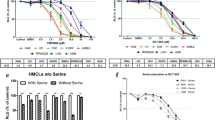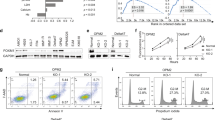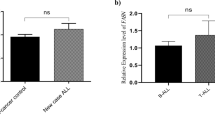Abstract
Objective
To determine fatty acid synthase (FAS) expression in human multiple myeloma and verify its potential as a therapeutic target in multiple myeloma.
Methods
FAS expression was determined by immunohistochemistry, reverse-transcription polymerase chain reaction (RT-PCR) and immunoblot analysis in bone marrow samples obtained from 27 patients with multiple myeloma (MM patients) and peripheral blood mononuclear cells (PBMCs) obtained from 12 healthy donors. In parallel, additional analyses were performed on 2 human multiple myeloma cell lines, U266 and RPMI8226. U266 cells were treated with cerulenin at various concentrations (5 to 320 μg/ml) for 24 h, and metabolic activity was measured by 3-(4,5-dimethylthiazol-2-yl)-2,5-diphenyltetrazolium bromide (MTT) assays. Apoptosis was evaluated by dual Annexin V/PI (propidium iodide) labeling and flow cytometry (FCM) in U266 cells treated with 20 μg/ml cerulenin for 12 h or 24 h.
Results
By immunohistochemistry, we found that 19 of 27 bone marrow samples obtained from MM patients expressed significantly high levels of FAS. Similarly, by RT-PCR, 22 of 27 bone marrow samples obtained from MM patients, U266 and RPMI8226 showed FAS expression, whereas PBMC samples from 12 healthy donors did not express detectable level of FAS. FAS protein expression was confirmed by immunoblot analysis in 16 of 27 bone marrow samples obtained from MM patients, U266 and RPMI8226 cell lines, and no FAS protein expression was detected in PBMC samples from 12 healthy donors. U266 cells were highly sensitive to cerulenin treatment, with a dosage-related effect on metabolic activity, as a measure for cell proliferation. U266 cells treated with 20 μg/ml cerulenin for 12 and 24 h also showed early sign of apoptosis with 56.9% and 69.3% Annexin V+/PI− cells, and late apoptotic and necrotic cells with 3.2% and 17.6% Annexin V+/PI+ cells.
Conclusion
Increased FAS expression existed in multiple myeloma samples and human myeloma cell lines. Cerulenin greatly inhibited metabolic activity/cell proliferation of U266 cells and induced apoptosis, suggesting that FAS is an effective target for pharmacological therapy in human multiple myeloma.
Similar content being viewed by others
References
Camassei, F.D., Cozza, R., Acquaviva, A., Jenkner, A., Ravà, L., Gareri, R., Donfrancesco, A., Bosman, C., Vadalà, P., Hadjistilianou, T., Boldrini, R., 2003. Expression of the lipogenic enzyme fatty acid synthase (FAS) in retinoblastoma and its correlation with tumor aggressiveness. Invest. Ophthalmol. Vis. Sci., 44(6):2399–2403. [doi:10.1167/iovs.02-0934]
Child, J.A., Morgan, G.J., Davies, F.E., Owen, R.G., Bell, S.E., Hawkins, K., Brown, J., Drayson, M.T., Selby, P.J., 2002. High-dose chemotherapy with haematopoietic stem-cell rescue for multiple myeloma. N. Engl. J. Med., 348(19):1175–1183.
Gabrielson, E.W., Pinn, M.L., Testa, J.R., Kuhajda, F.P., 2001. Increased fatty acid synthase is a therapeutic target in mesothelioma. Clin. Cancer Res., 7(1):153–157.
Gansler, T.S., Hardman, W., Hunt, D.A., Schaffel, S., Hennigar, R.A., 1997. Increased expression of fatty acid synthase (OA-519) in ovarian neoplasms predicts shorter survival. Hum. Pathol., 28(6):686–692. [doi:10.1016/S0046-8177(97)90177-5]
Garber, K., 2006. Energy deregulation: licensing tumors to grow. Science, 312(5777):1158–1159. [doi:10.1126/science.312.5777.1158]
Heiligtag, S.J., Bredehorst, R., David, K.A., 2002. Key role of mitochondria in cerulenin mediated apoptosis. Cell Death Differ., 9(9):1019–1025. [doi:10.1038/sj.cdd.4401055]
Kersten, S., 2001. Mechanisms of nutritional and hormonal regulation of lipogenesis. EMBO Rep., 2(4):282–286. [doi:10.1093/embo-reports/kve071]
Kuehl, W.M., Bergsagel, P.L., 2002. Multiple myeloma: evolving genetic events and host interactions. Nat. Rev. Cancer, 2(3):175–187. [doi:10.1038/nrc746]
Laemmli, U.K., 1970. Cleavage of structural proteins during the assembly of the head of bacteriophage T4. Nature, 227(5259):680–685. [doi:10.1038/227680a0]
Menendez, J.A., Lupu, R., 2004. Fatty acid synthase-catalyzed de novo fatty acid biosynthesis: from anabolicenergy-storage pathway in normal tissues to jack-of-all-trades in cancer cells. Arch. Immunol. Ther. Exp., 52(6):414–426.
Menendez, J.A., Vellon, L., Mehmi, I., Oza, B.P., Ropero, S., Colomer, R., Lupu, R., 2004. Inhibition of fatty acid synthase (FAS) suppresses HER2/neu (erbB-2) oncogene overexpression in cancer cells. Proc. Natl. Acad. Sci. USA, 101(29):10715–10720. [doi:10.1073/pnas.0403390101]
Pizer, E.S., Pflug, B.R., Bova, G.S., Han, W.F., Udan, M.S., Nelson, J.B., 2001. Increased fatty acid synthase as a therapeutic target in androgen independent prostate cancer progression. Prostate, 47(2):102–110. [doi:10.1002/pros.1052]
Rashid, A., Pizer, E.S., Moga, M., Milgraum, L.Z., Zahurak, M., Pasternack, G.R., Kuhajda, F.P., Hamilton, S.R., 1997. Elevated expression of fatty acid synthase and fatty acid synthetic activity in colorectal neoplasia. Am. J. Pathol., 150(1):201–208.
Swinnen, J.V., Roskams, T., Joniau, S., van Poppel, H., Oyen, R., Baert, L., Heyns, W., Verhoeven, G., 2002. Overexpression of fatty acid synthase is an early and common event in the development of prostate cancer. Int. J. Cancer, 98(1):19–22. [doi:10.1002/ijc.10127]
Takahiro, T., Shinichi, K., Toshimitsu, S., 2003. Expression of fatty acid synthase as a prognostic indicator in soft tissue sarcomas. Clin. Cancer Res., 9(6):2204–2212.
Wang, W.Q., Zhao, X.Y., Zhang, X.H., Gong, X.B., 2007. Cerulenin changes apotosis related genes expression in multiple myeloma cell line U266. Zhonghua Xue Ye Xue Za Zhi, 28:239–242 (in Chinese).
Wang, Y., Kuhajda, F.P., Li, J.N., Pizer, E.S., Han, W.F., Sokoll, L.J., Chan, D.W., 2001. Fatty acid synthase (FAS) expression in human breast cancer cell culture supernatants and in breast cancer patients. Cancer Lett., 167(1):99–104. [doi:10.1016/S0304-3835(01)00464-5]
Author information
Authors and Affiliations
Corresponding author
Additional information
Project supported by the Medicine and Health Research Fund of Zhejiang Province (No. 2007B091) and the Office of Education of Zhejiang Province, China (No. 20070104)
Rights and permissions
About this article
Cite this article
Wang, Wq., Zhao, Xy., Wang, Hy. et al. Increased fatty acid synthase as a potential therapeutic target in multiple myeloma. J. Zhejiang Univ. Sci. B 9, 441–447 (2008). https://doi.org/10.1631/jzus.B0740640
Received:
Accepted:
Published:
Issue Date:
DOI: https://doi.org/10.1631/jzus.B0740640




